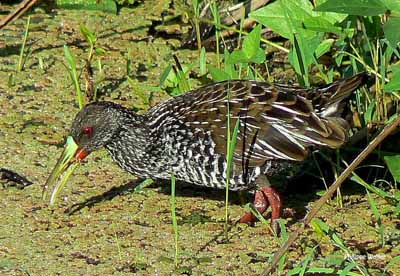
Spotted Rail
Pardirallus maculatus
Gruiforme Order – Rallidae Family
BIOMETRICS:
Length: 25-28 cm
Weight: M : 148-220 g – F : 130-190 g
DESCRIPTION:
Spotted Rail differs from other rails’ species in conspicuously streaked plumage and long bill.
Adults of both sexes are similar, with female slightly smaller than male.
Spotted Rail occurs in three morphs, dark, pale and barred.
Bird in dark morph has dark brown upperparts and dark-tipped underparts feathers with no white bars.
Bird in pale morph has pale greyish brown throat and breast, the latter weakly barred white.
Bird in barred morph has grey, spotted white throat. Breast and belly are conspicuously barred white.
PROTECTION / THREATS / STATUS:
Spotted Rail is locally common in some areas. This secretive bird is difficult to see, mainly during the breeding season, and this species is probably more widespread within its range than records suggest.
Spotted Rail populations are not threatened at this moment.
Fr: Râle tacheté
All : Fleckenralle
Esp : Rascón Overo
Ital: Rallo macchiato
Nd: Gevlekte Ral
Port: Saracura-carijó
Photographer:
Philippe Wolfer
OISEAUX D’ARGENTINE
Text by Nicole Bouglouan
Sources :
HANDBOOK OF THE BIRDS OF THE WORLD Volume 3 by Josep del Hoyo-Andrew Elliott-Jordi Sargatal - Lynx Edicions - ISBN : 8487334202
A GUIDE TO THE BIRDS OF MEXICO AND NORTHERN CENTRAL AMERICA by Steve N. G. Howell, Sophie Webb - Oxford University Press - ISBN: 0198540124
A GUIDE TO THE BIRDS OF COLOMBIA by Steven L. Hilty and William L. Brown - Princeton University Press – ISBN 069108372X
BirdLife International (BirdLife International)
SORA Searchable Ornithological Research Archive (Blair O. Wolf)

Spotted Rail has spotted and barred black and white plumage overall. Head, neck and breast are black spotted white. Belly, flanks and vent are conspicuously barred black and white, whereas throat and undertail coverts are white. The upperwing shows brownish streaking, as the uppertail coverts.
The bill is long and greenish-yellow, with a small red spot at base of lower mandible. Eyes are red. Legs and feet are pinkish red.
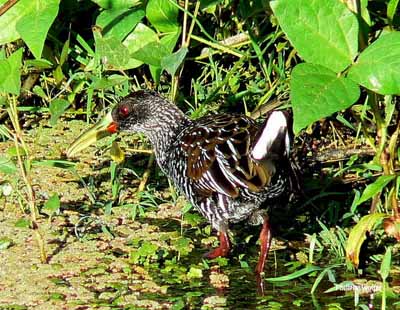
Immature is browner than black. Underparts show weak white barring and spotting. Eyes are brownish. Bill and legs are duller.
We find two subspecies which differ in upperparts pattern:
P.m. maculatus, from W Cuba, Hispaniola, Jamaica, Trinidad and Tobago, Colombia, Guianas and Brazil, and S to Peru and Argentina.
P.m. insolitus, from Mexico to Costa Rica. This one has rather spotted than streaked plumage, pure white throat and lighter brown upperparts.
VOICE: SOUNDS BY XENO-CANTO
Spotted Rail utters loud, rasping, repeated screech, often preceded by short grunt “kr-krreih krreih” or “grrr” repeated.
We can also hear a deep gruff, pumping series “wuh-wuh…” or “um-um…” accelerating towards the end.
When disturbed, it gives a sharp “gek” often repeated.
It may sometimes call at night.
HABITAT:
Spotted Rail frequents freshwater marshes, paddy-fields, grassy ditches, wet grasslands and irrigated fields. This species needs dense cover of vegetation such as reeds and rushes. It can be seen from lowlands up to 2000 metres of elevation.
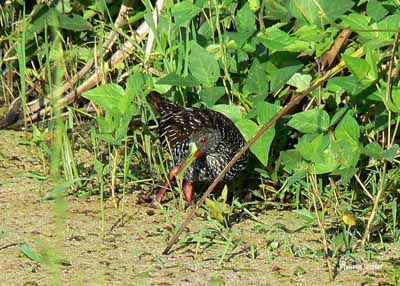
RANGE:
The two subspecies share the range (see above).
BEHAVIOUR:
Spotted Rail feeds in fairly open areas at any time of the day. But this secretive bird leaves the cover protection mainly in the early morning and in the late afternoon to feed.
Spotted Rail feeds on earthworms, insects (adults and larvae), several invertebrates and small fish. It also consumes some vegetation such as pondweeds. It forages by wading or at the edge of water, and probes into the mud with the long bill.
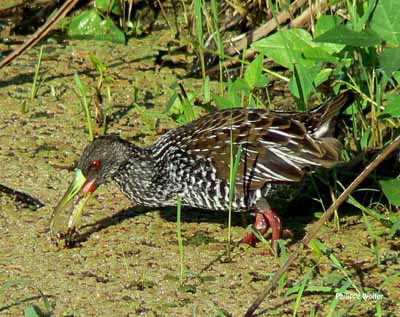
Spotted Rail runs rapidly when crossing open areas. It has well developed strong legs with long and slender toes. Rails are able to walk and run into dense cover, thanks to their slim body. They can “compress” the body, in order to move between the stems. They also can swim, using the wings underwater if necessary. Spotted Rail frequently climbs into vegetation using its wings as balance, but it descends by flying.
The breeding behaviour is poorly known, but usually, the male performs some displays such as courtship feeding and allopreening, and adopts some postures in order to display the white undertail coverts with raised tail, and the plumage pattern with raised wings. Displays are often accompanied by calls.
Spotted Rail seems to be sedentary in its range, only performing some local movements according to weather conditions and water levels.
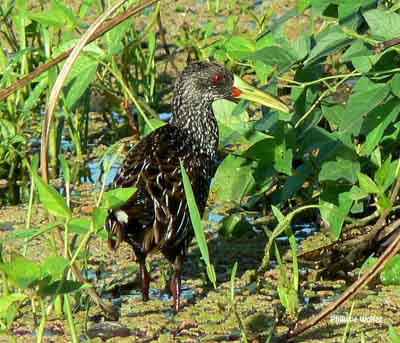
FLIGHT:
Spotted Rail rarely flies as numerous Rallidae. This bird has relatively short, broad, rounded wings. When in flight, it travels short distances with low, weak flight, and often with dangling legs.
REPRODUCTION:
Breeding season varies according to the range.
Spotted Rails are monogamous and territorial during the breeding season.
The nest is placed low in marshy vegetation, just above the water. It may be a platform of grasses or a bowl made with dry rushes.
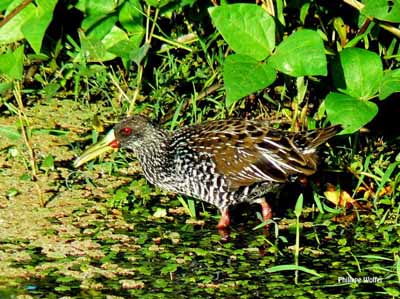
Female lays 2-7 pale buff eggs with dark markings at larger end. Incubation period is unknown, but probably varies between 13 to 31 days.
Chicks are covered in down, and they usually are precocial or semi-precocial. They may swim and dive very soon after hatching if necessary.
They are fed by both parents and probably fledge at one or two months of age.
Rails may produce one or two broods per year.
DIET:
Spotted Rail feeds by probing into the mud at water edge, catching mainly earthworms, insects (adults and larvae), small fish and other invertebrates. It also consumes some aquatic plants.
